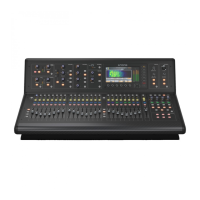40 M32 - Digital Console User Manual 41
1. The screen displays a multi-segment
level meter showing the strength of the
talkback signal as it has currently been
set. It also displays a multi-segment gain
reduction meter, showing the user how
much compression has been automatical-
ly applied to the talkback signal.
2. Tap the rst rotary control to enable the
talkback circuit. The internal/external
talkback microphone will now transmit
audio to the talkback path’s assigned
destination.
3. Adjust the third control to set the gain of the talkback signal. This is an additional gain stage that follows the
initial gain stage set by the top panel TALK LEVEL control.
4. Tap the third control to toggle on/o the talkback circuits ‘auto-dim’ function. This function is useful in a studio
setting, and will automatically dim the control room outputs when the talkback circuit is active. This prevents the
talkback microphone from picking up too much sound from the nearby studio monitors.
5. Adjust the fourth control to scroll through the various talkback destinations, which include:
• Mix Bus 1-16
• LR Bus
• Centre/Mono Bus.
6. Tap the fourth control to activate any talkback destination when it is currently selected. Multiple talkback destina-
tions can be selected, allowing the talkback signal to reach many destinations at the same time.
7. Tap the fth control to toggle the dedicated top-panel talkback buttons between latching and non-latching
operation.
8. Turn the sixth control to adjust the brightness of the lamp that is connected to the console’s rear panel lamp
connector.
9. Tap the sixth control to toggle the attached lamp on or o.
oscillator Tab
The oscillator tab oers controls for the console’s onboard oscillator, a very handy tool that can be used for setting up PA
systems and testing various signal ow paths without the need for a live source feeding a microphone. Settings include
oscillator type, frequency, volume and routing
destinations.
To adjust the various settings on the oscillator
tab, perform the following steps:
1. Adjust the rst rotary control to set the
level of the onboard oscillator.
2. Tap the rst control to toggle the oscilla-
tor on or o.
• The Main Display shows a multi-seg-
ment level meter that shows the current level of the oscillator.
3. Adjust the second control to set the frequency of the primary onboard oscillator.
4. Adjust the third control to set the frequency of the alternate onboard oscillator.
5. Tap the third control to alternate between Sine F1 and Sine F2.
6. Adjust the fourth control to select the type of oscillator to be used. Choices include:
• Sine Wave
• Pink Noise
• White Noise.
7. Tap the fourth control to engage the selected oscillator type.
8. Adjust the sixth control to select a destination for the onboard oscillator. Choices include:
• Mix Bus 1-16
• Main L Bus
• Main R Bus
• Main L+R Bus
• Main Centre / Mono
• Matrix Outputs 1-6.
9. Tap the sixth control to assign the selected oscillator destination.
www.theaudiospecialists.eu

